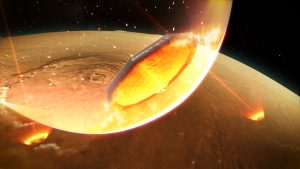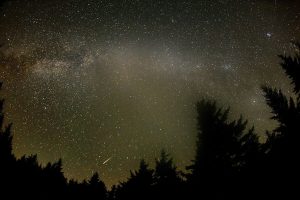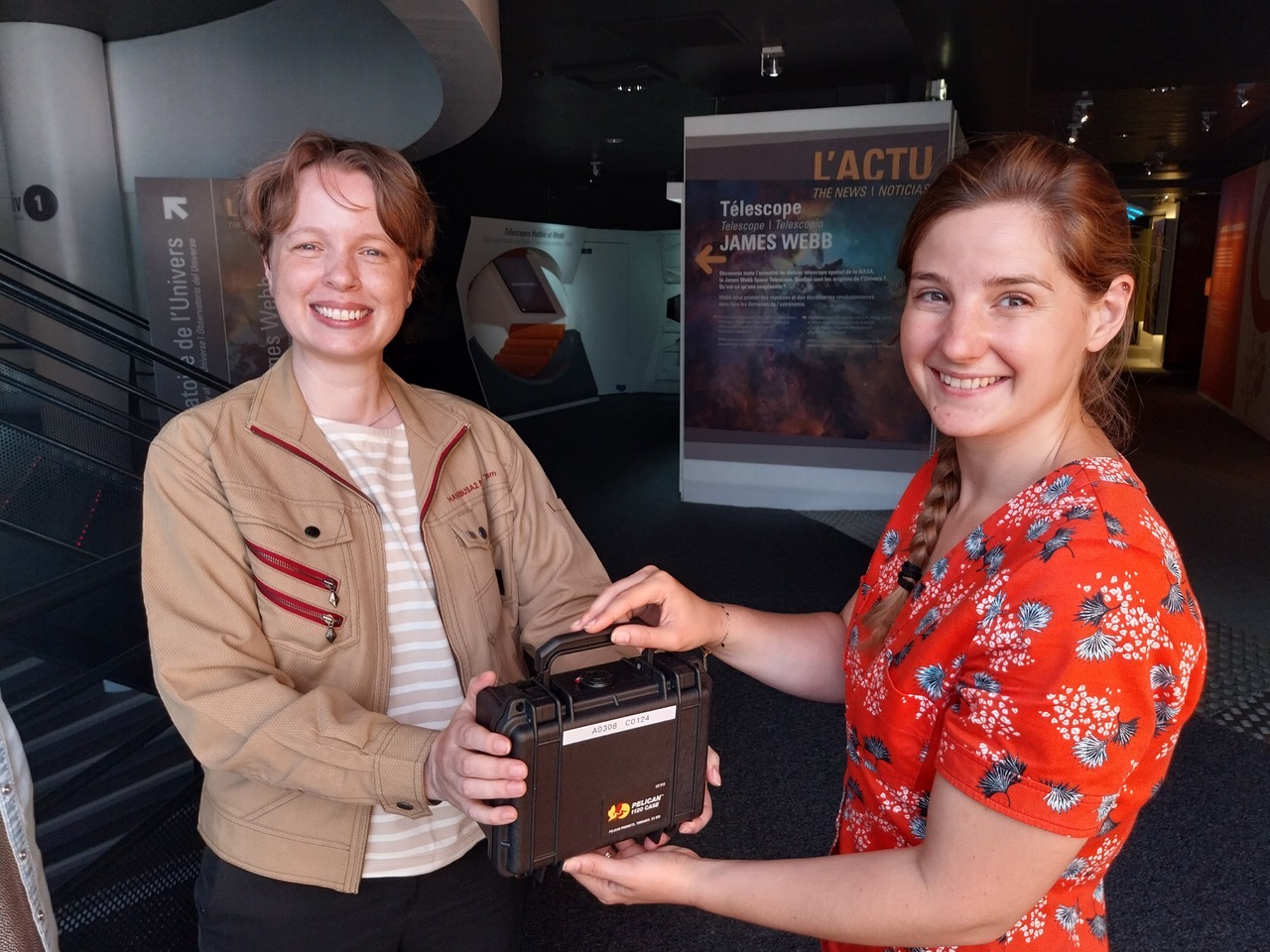
How to carry an asteroid around the world
Reported by Elizabeth Tasker (Assoc. Prof.)
Dept. of Solar System Sciences
It was very early in the morning when I approached the airport customs desk, cradling a protective black box in my arms. Nestled inside the fitted foam interior were two tiny grains as old as the Solar System itself.
In December 2020, the Hayabusa2 mission released a capsule containing grains from asteroid Ryugu that parachuted through the Earth’s atmosphere to land in the Australian Woomera desert. The container within was tightly sealed to prevent any contamination from Earth, and the retrieval teams worked rapidly to locate the landing site and bring the capsule back to Japan. From there, analysis began first in Japan and then at laboratories around the world to understand the history of asteroid Ryugu, and what the grains could reveal about the formation of our own habitable planet.
All of this research took place in meticulously sterilised clean rooms, and very few people had been able to see the asteroid grains with their own eyes. But this was about to change.
At the airport customs desk, I handed the two officials the export declaration forms, printed in duplicate. The forms stated that the grains had no commercial value, were not subject to quarantine, and most definitely not for consumption. Placing the case on the counter, I flipped open the lid. The metal of a sealed facility-to-facility transfer container, known as an FFTC, glinted in the airport lights as we all leaned in. In the centre, visible through the quartz glass viewing window, was a tiny particle from outer space.
About 18 months previously, the Science Museum in London had approached ISAS. Would we consider loaning a grain from asteroid Ryugu to go on public display in the UK? Conversations were soon extended to include Cité de l’espace in Toulouse, who were also keen to display the asteroid sample.
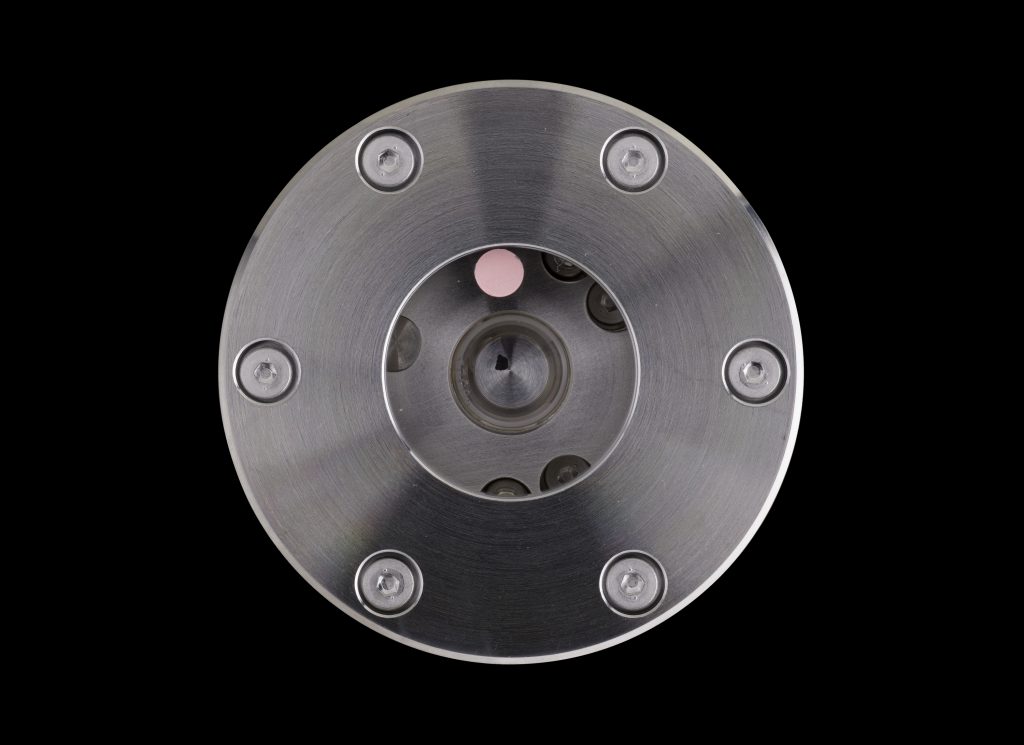
While the majority of the grains returned by Hayabusa2 are reserved for scientific study, a small number have been put aside for outreach. Public displays allow far more people to see the asteroid grains, which Astromaterials Science Research Group Manager Usui Tomohiro notes is a rare feature of sample return, even for scientists.
“Space exploration gives us incredible ‘images’ of asteroids, planets, and the Universe,” says Usui. “But these images are seen through the eyes of telescopes and spacecraft. The returned sample is only substance that you can ‘see’ with your naked eye and ‘touch’ with your hands.”

Outreach is also a way for the mission to invest in the future by inspiring young scientists who might one day study the sample. Similar to the lunar samples collected during the Apollo program, the Hayabusa2 curation team has placed 60% of the retrieved sample in vacuum storage for future analysis.
“A substantial fraction of the returned sample is preserved for future generations,” explains ISAS Deputy Director General Fujimoto Masaki. “They will analyse the samples with the new analytical technology to come, and with questions that we cannot even think of today. Therefore there should be a fraction reserved for outreach activities to inspire the future generations.”
I’d worn my Hayabusa2 mission jacket to the airport, hoping that it would lend credence to the claim that I was carrying a piece of actual asteroid. Unlike the asteroid grains transported for scientific study, the grains for outreach activities could pass through the regular airport security scanners. This should have made the necessary export paperwork straightforward, but the situation was so rare that there was no precedent to offer reassurance. As I stood at the customs desk, I hoped that everyone would realise that a story of a spacecraft collecting a sample from an asteroid 300 million kilometres away in space was too wild for fabrication.
The customs officials disappeared briefly, before returning with one set of the export forms that had been stamped. I let out my breath. We were cleared for flight.
The museum teams in London and Toulouse had kept in close contact with us, sharing plans for the exhibit, discussing the information to accompany the displays, and exploring ideas to ensure the tiny grains were as visible as possible.

The Science Museum in London would display the asteroid grain within the FFTC close to the floor of the display case, to enable children and wheelchair users a clear view. A mirror would reflect the grain image upwards to taller visitors who did not want to stoop. Cité de l’espace asked if they could loan two grains, one in the FFTC that are always used for scientific study, and one sealed in epoxy resin that could be turned sideways to allow a clearer view from different angles. The ISAS curation team also printed three dimensional replicas of the grains that had been enlarged to give a better view of the grain shape and structure.
Back at the airport, I winced as the tray containing the asteroid grain in its protective case bumped along the security scanner conveyer belt. I took a deep breath. Ryugu had survived 4.56 billion years in space. Surely it could survive Haneda Airport.
Yada Toru, leading the Hayabusa2 sample curation at ISAS, had prepared the Ryugu grains for travel to Europe. The FFTC had to be kept vertical, and Yada demonstrated how to rotate the container inside the protective case when this needed to be laid flat. If the container was kept on its side, there was a risk the grain would rest on its edge and potentially fragment: a truly terrible prospect!
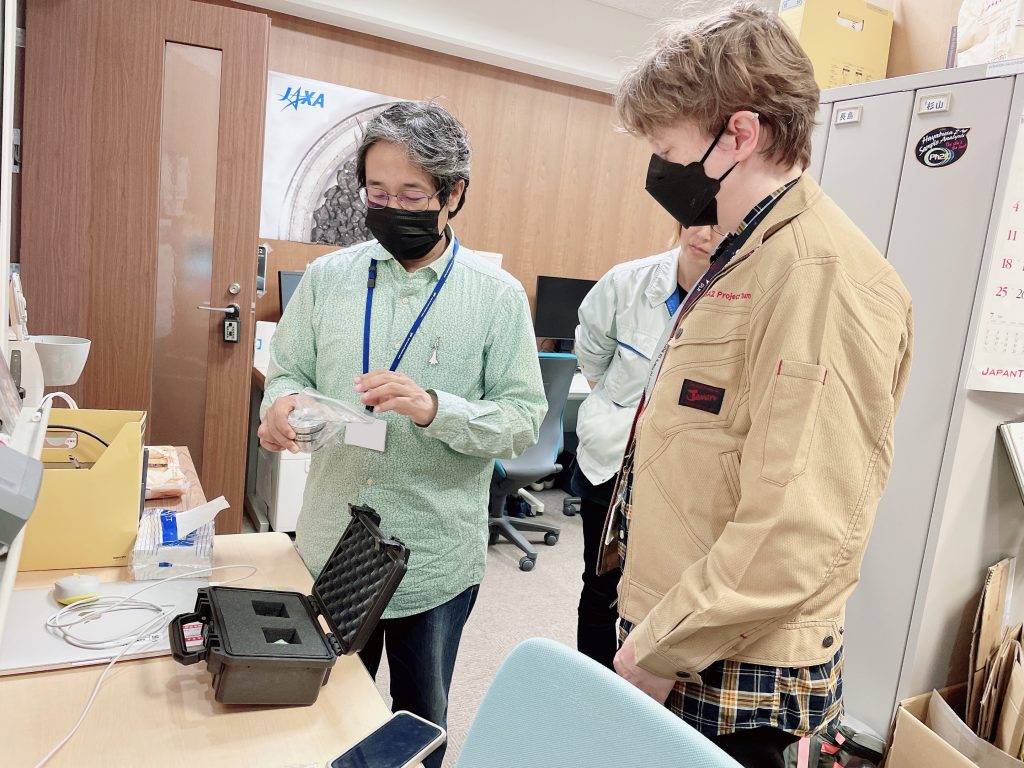
Asteroid Ryugu is a C-type (carbonaceous) asteroid. This asteroid class is thought to be relatively common in our Solar System, yet less than 10 of the tens of thousands of meteorites we have found on Earth are of this type. The reason is believed to be the fragile nature of the material, which would usually disintegrate while passing through the Earth’s atmosphere. Coupled with the issue of contamination from Earth, sample return missions are therefore the only way to study this type of rock that researchers believe may have delivered vital ingredients for life to Earth.
The protective case had done its job. I checked the integrity of the Ryugu grains before sealing up the case and sliding it under the aeroplane seat. This first trip was to courier two asteroid grains to France, with the delivery to the UK planned for the following month. Once in my hotel in Toulouse, I looked out across the Cité de l’espace as the sun set, turning the Ariane rocket in the grounds a soft pink. I placed the case gently on the windowsill so the asteroid grains could see their new home.
The display in Toulouse was due to open on September 9, 2023. It was great timing, as Japan would be playing in the Rugby World Cup in Toulouse the same weekend as the Cité de l’espace exhibit opened, providing a unique chance for visiting fans to explore Japan space as well as sports.

Speaking about the exhibit, the Director of Education, Science and Culture at Cité de l’espace Christophe Chaffardon and museographer Eglantine Lelong said, “At Cité de l’espace (Toulouse), the exhibitions echo international Space News. Thanks to JAXA’s precious loan, our visitors are invited to learn more about Japanese expertise regarding sample return. In our ‘Solar System Quay’ exhibition area, the Ryugu samples will be displayed near to our treasure: the Moon stone, brought back by Apollo 15 mission. We are also very happy to present a shining example of JAXA and CNES (French Space Agency) cooperation. Other joint missions should be very interesting to follow in the future.”
A few weeks later, I returned to the airport to travel to London. In addition the grain inside the FFTC, I was also carrying a scale model of the Hayabusa2 spacecraft that would form part of the London display. The model was also fragile, and I was holding two seat tickets to allow the miniature spacecraft to sit beside me rather than risk jostling in the overhead bins or as checked baggage. Since the model was a more routine item to be carrying and significantly younger than 4.56 billion years, I was expecting no problems. But as with the scientific analysis of the asteroid grains, there are always surprises.
The Science Museum exhibit was scheduled to open the same week as the exhibit at Cité de l’espace, on September 7, 2023. This was also excellent timing from the perspective of international space news, as the NASA OSIRIS-REx mission would return to Earth a few weeks later to deliver America’s first asteroid sample to Earth. JAXA and NASA had worked closely together throughout the Hayabusa2 and OSIRIS-REx missions, and the two samples will form the first comparative study of asteroids, revealing far more about our Solar System origins than a single sample (with the risk of being a misleading outlier) could do alone. We hoped the display of the Ryugu sample would allow spectators to this asteroid return feel more connected to the mission and the science to come. But first I had to be able to board the aeroplane.

The seat ticket for the Hayabusa2 model needed to be booked as a “baggage ticket”. However, both the tickets I was carrying had been accidentally booked as regular seats. Despite a ticket for a human passenger being the more expensive option, I was not allowed to board with the current arrangement.
What followed was an immensely tense four hours. I was glad I had arrived early, but regretted forgoing a water bottle before security. The airline staff worked hard to resolve the situation, but various issues such as the availability of seatbelt extenders to hold the model securely had to be confirmed for both my flight out of Tokyo and the second connecting flight to London.
“You are an awkward shape,” I muttered at the spacecraft sitting silently by my feet.
To my intense relief, I was eventually cleared to board. I had already visited customs, so I was dashed through the crew line for security to meet my imminently boarding flight. As I placed by bags to pass through the security scanner, I wondered if I should have mentioned to the slightly panicked looking staff beside me that I was also carrying an asteroid sample.

Both the Science Museum and Cité de l’espace had planned events to mark the opening of the exhibits. Fujimoto Masaki and the Director of JAXA Space Education Kate Kitagawa, who had both been at the forefront of arranging the collaboration with JAXA, visited Toulouse and then London to chat with the first visitors.
At Toulouse, a round-table discussion was held with Fujimoto, Jean-Pierre Bibring (l’Institut d’Astrophysiques Spatiales) and Aurélie Moussi (CNES), while London hosted an evening “Lates” event to discuss asteroid science.
Speaking about the display in London, museum curator of space technology, Heather Bennett said, “Working with JAXA has given the Science Museum a unique opportunity to tell our visitors all about asteroid sample return, and how these missions are helping to unlock the secrets of the early Solar System, and even the origins of life on Earth. We’re delighted to give our visitors the chance to come face to face with a real sample of 4.6 billion year-old asteroid, and tell the remarkable story of the Hayabusa2 mission.”
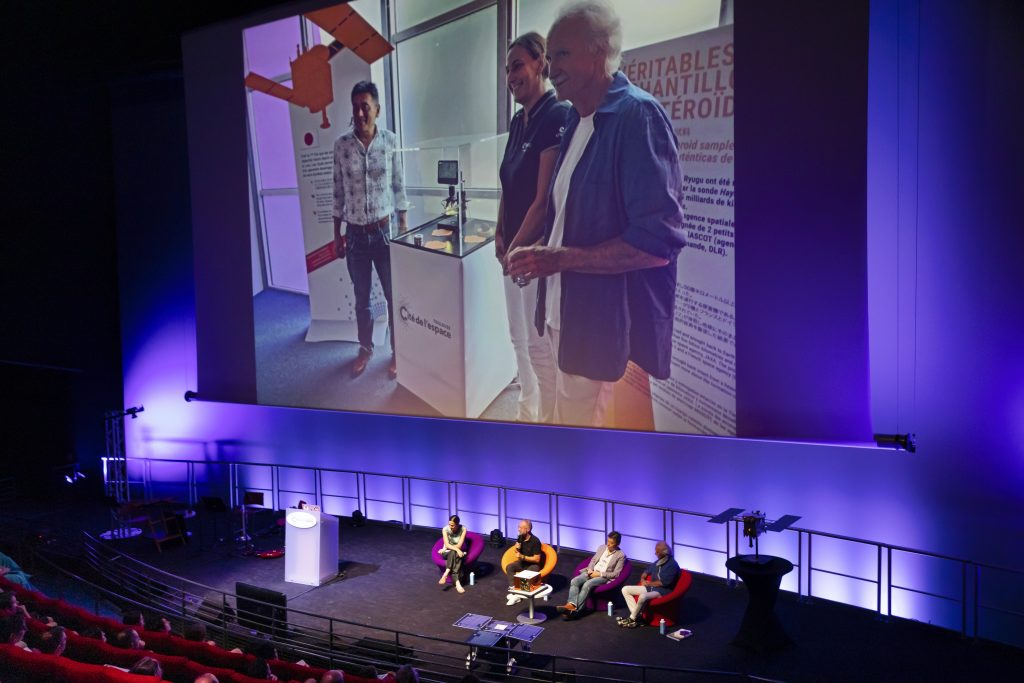
As the museum opened the exhibit, visitors gathered to see the fragment of asteroid returned to Earth, Deputy Director of the Science Museum Julia Knights looked towards the future,
“The Hayabusa2 display at the Science Museum in London has been hugely popular with our visitors, who love the idea of getting close up to the 4.6 billion year old asteroid. I’d like to thank JAXA and ISAS and especially, Professor Fujimoto and Dr Kitagawa, for all their help to make this exhibit possible. It was especially poignant to welcome them both to the Science Museum in September and for Professor Fujimoto’s participation on the Asteroids panel discussion at our Stargazing Lates evening event. I hope this is just the beginning of a long friendship and collaboration between JAXA and the Science Museum and that JAXA will play an important part in our upcoming new international Space Gallery”
At the aeroplane door, I opened the model box to show the flight crew the contents.
“Is that the spacecraft that went to space?!” I was asked.
It is a beautifully detailed and accurate model, but twenty times smaller than the real Hayabusa2!
The real Hayabusa2 did not return to the Earth’s surface. After separating the sample capsule containing the grains from asteroid Ryugu, the spacecraft turned away from the Earth and back into deep space. Now renamed “Hayabusa2#”, the spacecraft’s extended mission will visit two more asteroids. A high-speed fly-by of asteroid 2001 CC21 is planned in 2026, and a more detailed exploration of asteroid 1999 KY26 in 2031. In addition to testing the endurance of the spacecraft components and instruments over a long duration, the mission will also tell us more about different classes of asteroid that may one day pose a threat to the Earth.
I had to pass through security one final time during my flight connection to London. As the protective case slid through the scanner, the airport security staff gestured at the box.
“What does this contain?” she asked.
“It’s an asteroid fragment,” I replied. “I’m taking it to the museum so it can be seen by millions of people.”
Further information:
Hayabusa2 mission website
Astromaterials Science Research Group (curation) website
London Science Museum exhibition information
Cité de l’espace exhibition information
 Previous Post
Previous Post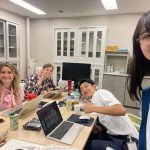 Next Post
Next Post